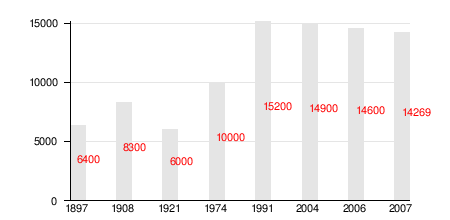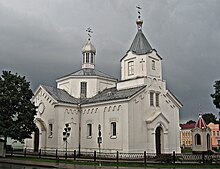Ashyany
| Ashyany | Osmyany | |||
| Ашмяны | Ошмяны | |||
| ( Belarus. ) | ( Russian ) | |||
|
|||
| State : |
|
||
| Woblasz : |
|
||
| Coordinates : | 54 ° 25 ' N , 25 ° 55' E | ||
| Height : | 200 m | ||
| Residents : | 14,160 (2009) | ||
| Time zone : | Moscow time ( UTC + 3 ) | ||
| Telephone code : | (+375) 1593 | ||
| Postal code : | 231100 | ||
| License plate : | 4th | ||
| Website : | |||
|
|
|||
Aschmjany ( Belarus. Ашмяны , Ašmiany , Russian. Ошмяны / Oschmjany , lit. Ašmena , Polish Oszmiana ) is a city in northwest Belarus , in the Hrodsenskaja Woblasz , capital of the Aschmjany Rajon . The city is located 133 kilometers from Minsk and 52 kilometers from the Lithuanian capital Vilnius .
coat of arms
Description: The coat of arms is split into red and blue and a silver low tip is inserted below . In front a natural hand protruding from the edge of the shield holds a golden balance beam ; behind a golden breastplate turned to the right and at the top a red bull .
history
The first mention of Ashmyany (in the Lithuanian Chronicles ) tells that Jaunutis inherited the city after the death of Gediminas ( 1341 ). In 1384 Aschmjany was destroyed by the Knights of the Teutonic Order , who fought against Władysław II Jagiełło , but was soon rebuilt. Another attack by the knights of the order on the city in 1402 could be repelled, so that the attackers had to retreat to Medininkai for the time being .
By 1413, Ashyany had developed into one of the most important commercial and economic centers in the Vilnius Voivodeship . Due to its economic importance, the city became a focal point of the disputes between Žygimantas Kęstutaitis and Švitrigaila , who was in league with the Teutonic Order. After the victory of Kęstutaitis Ashmyany was added to the private property of the Grand Dukes of Lithuania and began to develop rapidly. This phase came to an end in 1519 when Ashmyany was burned to the ground by troops of the Grand Duchy of Moscow . The city recovered from the recent destruction much more slowly than from the first destruction. Therefore, the city was granted some privileges in 1537 that were intended to promote reconstruction. In 1566, Aschmjany gave itself a city constitution according to Magdeburg law , which was finally granted by Johann III in 1683 along with some privileges for the merchants and citizens resident in the city . Sobieski was officially confirmed. In the 16th century, Ashmyany was considered the most important center of Calvinism in Poland-Lithuania . This was due to Mikołaj Radziwiłł , who had founded a Calvinist college and church in Aschmjany.

In 1792, King Stanisław August Poniatowski confirmed all of the city's preexisting privileges and also granted it the status of a free city that was only subject to the king and the city council. It was also at this time that the city received its first coat of arms , which was divided into three fields showing a shield, a hand with scales and the personal coat of arms of King Stanisław August Poniatowski.
As a result of the Polish partitions , Ashyany was annexed by the Russian Empire in 1795 . During the November uprising of 1830/31 the Russians were expelled from the city for a short time, but the insurgents were forced to retreat into the woods by Russian troops as early as April 1831. After a brief skirmish, a Russian force of 1,500 men marched into the city and burned it down. Although Ashyany was then partially rebuilt, the city did not recover from this blow. Towards the end of the 19th century it was only of provincial importance. At that time, it was mainly inhabited by Jewish immigrants who had moved to Ashyany from other parts of Russia and built a synagogue in Ashyany in 1912.
After the First World War and the Polish-Soviet War , Ashyany belonged to Poland. In the wake of the invasion of Poland by the Third Reich , the city was occupied by the Soviet Union. After the attack on the Soviet Union began , Ashyany was captured by troops of the Third Reich and held until 1944. In 1945 the city was annexed by the Soviet Union and added to the Belarusian SSR . It has belonged to Belarus since 1991 .
Population development from 1897
The following diagram shows the population development of Ashyany:

Striking buildings
- Catholic Church of Saint Michael the Archangel
- Catholic Franciscan Church, built in 1822
- Synagogue , built in 1902
- Orthodox Church of the Resurrection, built in 1875
- Watermill
sons and daughters of the town
- Andrei Barbaschinski (* 1970), handball player
- Franz Klinzewitsch (* 1957), Russian politician
- Viktor Martinowitsch (* 1977), writer
literature
- Oszmiana , in: Guy Miron (Ed.): The Yad Vashem encyclopedia of the ghettos during the Holocaust . Jerusalem: Yad Vashem, 2009 ISBN 978-965-308-345-5 , pp. 562-564
Web links
- Official website of the city (Russian)
- Photos of the city at Radzima.org (Belarusian)
- Photos of the city at Globus.tut.by (Russian)
Individual evidence
- ↑ В. М. Ляŭко. Сярэдневяковыя старажытнасці Беларусі: Новыя матэрыялы i даследаванні, 1993. С. 40.






